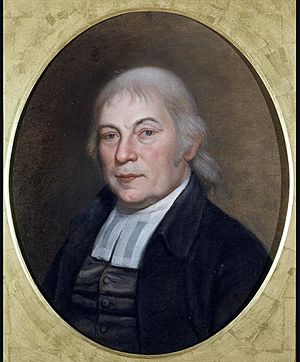Gotthilf Heinrich Ernst Muhlenberg facts for kids
Gotthilf Heinrich Ernst Muhlenberg (born November 17, 1753 – died May 23, 1815) was an American church leader and a scientist who studied plants, known as a botanist.

Contents
Who Was Gotthilf Muhlenberg?
Gotthilf Muhlenberg was born in Trappe, Pennsylvania. His father was Heinrich Melchior Muhlenberg, a well-known church leader. Gotthilf became famous for his work with plants.
Early Life and Education
Gotthilf started his education in Germany in 1763. He studied at Franckesche Stiftungen and later at the University of Halle. He returned to Pennsylvania in September 1770. Soon after, he became a Lutheran minister. He served in churches in Pennsylvania and New Jersey. He also earned a special degree, a Doctor of Divinity, from Princeton University.
In 1774, Gotthilf married Mary Catherine Hall. They had eight children together. When the American Revolutionary War began, he had to leave Philadelphia. He went back to his hometown of Trappe. It was there that he started to seriously study plants.
A Life of Service and Science
From 1780 to 1815, Muhlenberg was the pastor at Holy Trinity Church in Lancaster, Pennsylvania. Even while leading his church, he continued his scientific work. In 1785, he became a member of the American Philosophical Society. This was a group for important thinkers and scientists. In 1787, he also became the first president of Franklin College.
Muhlenberg is best known for his work as a botanist. He spent much of his time studying and describing plants. A type of grass called Muhlenbergia was named in his honor. This shows how important his work was in the world of plants. He wrote two major books about plants. These books helped other scientists learn about the plants of North America.
Discovering New Plants
Muhlenberg's main books were Catalogus Plantarum Americae Septentrionalis (published in 1813) and Descriptio Uberior Graminum et Plantarum Calamariarum Americae Septentrionalis Indiginarum et Cicurum (published in 1817). These books listed and described many plants. They were very important for understanding the plants of North America.
The Mystery of the Bog Turtle
Gotthilf Muhlenberg also discovered and identified the bog turtle. He found this small turtle while studying plants in Lancaster County, Pennsylvania. In 1801, the turtle was named Clemmys muhlenbergii to honor him. For a long time, it was called Muhlenberg's tortoise. However, in 1956, its common name was changed to the bog turtle. This happened because people started to prefer not naming animals after individuals.
His Last Years
In 1815, Muhlenberg had a stroke. This made it hard for him to move and work. But with help from his daughter, he kept writing letters to other scientists. Even though his condition seemed to get better for a short time, he had more strokes soon after. He passed away on May 23, 1815. Gotthilf Muhlenberg is buried in Woodward Hill Cemetery in Lancaster, Pennsylvania.
His Family Legacy
Gotthilf Muhlenberg came from a very important family. His brothers were Frederick and Peter Muhlenberg. Frederick was a politician, and Peter was a general in the Revolutionary War. Gotthilf's son, Henry A. P. Muhlenberg, also became a notable figure. His grandson, Frederick Augustus Hall Muhlenberg, was a doctor. This grandson's son, also named Frederick Augustus Muhlenberg, became the first president of Muhlenberg College. This college was named after their family.

